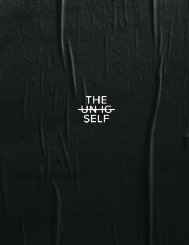Chip Thomas: The Good Fight
You also want an ePaper? Increase the reach of your titles
YUMPU automatically turns print PDFs into web optimized ePapers that Google loves.
MEDICINE + ART
Seeking to bring awareness to the issues
faced by people in this region, Thomas
began using a lifelong photographic hobby
to create “wheatpaste” posters - large photos of
Navajo residents glued with a water-flour mixture
to water tanks, grain silos, and roadside art stands.
I spoke with him recently in Joshua Tree, California,
where he was working on a new installation.
Photos top to bottom:
1. Chip Thomas with his
mural at Cow Springs
by Dawn Kish, 2016.
2. Rose Hurley and her
great Grandson, Edzavier
by Jetsonorama, 2019.
3. Stephanie in Cow Springs
by Jetsonorama, 2014; photo
by Ben Knight, 2015.
JUST AS ESCAPED SLAVES FOUND SOLACE
IN INDIGENOUS COMMUNITIES BACK IN THE
DAY, I HAVE FOUND THAT HERE WHERE I FEEL
THAT THE WORK I DO MAKES A DIFFERENCE.
What led you to take your photography of
Navajo residents and wrap it around issues
such as global warming and social justice?
I started photographing in black and white
documentary style in 1987, when I first moved
to the Navajo nation. From the beginning,
I enjoyed spending time with people as they
went about their day-to-day chores such as
hauling wood, coal, and water, or just being
with family. I attempted to tell stories
of community members I photographed.
As a person of color raised in the South, my
concern for social justice comes easy. I’ve always
been interested in cultures from around the world.
Social studies was my favorite subject in primary
school. Photographing and storytelling in the context
of the reservation was an organic evolution.
Explain how your art connects with
issues of health and the environment.
As a physician, I see a lot of older men with
chronic lung problems who use supplementary
oxygen in order to perform activities of daily
living. The majority worked in the uranium mines
on the Navajo nation in the WWII and Cold War
era and are suffering health consequences from
the lack of protection and information afforded
to them at that time. When companies started
mining uranium here in the 1950s and studying
the Navajo miners (without telling them of the
health consequences of their work), it was thought
initially that the Diné, or Navajo, had a gene
that prevented them from getting cancer because
the rates were so low. However, various cancer
rates in the Diné exceed the national average.
In light of multinational mining companies
wanting to mine the north and south rims of
the Grand Canyon for uranium, which will be
transported across the western part of the Navajo
9





